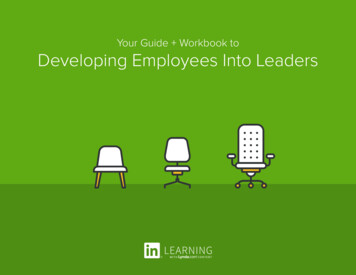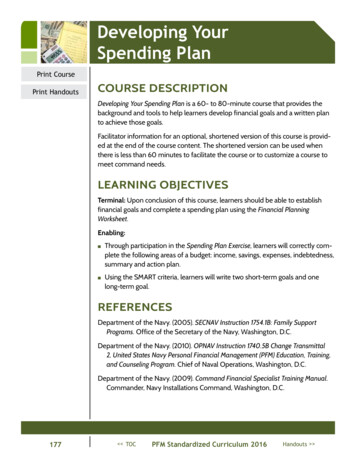
Transcription
Your Guide Workbook toDeveloping Employees Into Leaders
The most successfulcompanies don’trecruit leaders.They grow their own.ONLY13%of companies saythey do an excellentjob developingleaders at all levels.Yikes.A leadership shortage is one of the biggestbarriers to growth at companies around theworld. In fact, developing new leaders is theNo. 1 talent challenge facing organizationsworldwide, with 86 percent of companiesrating it as “urgent” or “important.”1Skilled leaders are in short supply, with85 percent of executives not confident intheir leadership pipelines.212IntroWHY?ImpactQualityDeloitte University Press, Leaders at All LevelsDevelopment Dimensions International, Global Leadership Forecast, 2014-2015HOW?Key driversGoalsBuy-inGapsCultureChampionsTools2
These challenges are particularly important as older leadersretire at accelerating rates and millennials assume leadershiproles. According to Forbes, millennials will comprise 75 percentof the workforce by 2025. Millennials are no longer the leaders oftomorrow — they are rapidly becoming the leaders of today.The data shows that many organizations are not preparingmillennials for management positions. And yet, if millennials aren’tpromoted, there’s a good chance they’ll go elsewhere.A substantial 66percent of companies say they’re “weak”in developing millennial leaders. At the same time, employeesdescribe opportunities to develop their own leadership skills astheir No. 1 reason for staying with an organization.11IntroDeloitte University Press, Leaders at all levels, 2014WHY?ImpactQualityHOW?Key driversGoalsBuy-inGapsCultureChampionsTools3
Three dynamics thatdrive successfulleadership developmentInvesting in yourtalent matters.We’re experiencing a training gap, not a skills gap.Companies agree that developing leaders iscritical, and yet research shows they are doing littleabout it. Specifically, 61 percent of companies offerno leadership training. No wonder there is aleadership shortage.A healthy talent pool ofengaged employeesTo sustainably grow, organizations are shifting fromviewing leadership development as a “nice to have”to a “need to have”. Leadership development programsare mission critical to organizational success.Robust training that activelydevelops that talentJoin us in developing the next generation of leaders.Use this guide to transform the way your leaders aresourced, developed, and retained.A culture that identifies andpromotes employees from withinIntroWHY?ImpactQualityHOW?Key driversGoalsBuy-inGapsCultureChampionsTools4
ContentsWhy?How?1Your leaders drive the bottom line1What are the key drivers?2Quality talent sticks around2What are the organization goals?3How can you get executive team buy-in?4What are your leadership skills gaps?5How can you create a learning culture?6Who are your learning champions?7What tools will help measure success?This is an interactive workbookUse the fields in this PDF to take notes, answerquestions, and learn. Go ahead, give it a try!What’s your name?IntroWHY?ImpactQualityHOW?Key driversGoalsBuy-inGapsCultureChampionsTools5
Whyshould you build an organization that invests heavily in its leadership?1The performance of yourleaders has a massiveimpact on your bottom line.Most executives instinctively know that strong leadershipis essential for overall organizational success. However, inmost organizations there is a lack of urgency to improveleadership skills driven by a belief that an organization’scurrent leadership capacity — and subsequentperformance — is good enough. But is it?Statistics show that the average organizationis forfeiting over 1 million per yearin untapped potential and lose as much as50 percent productivity because ofless-than-optimal leadership practices.1Regardless of company size, developing great leadersdeserves investment. That investment serves as acompetitive advantage, as it ensures your managersare getting the most out of your workforce.1IntroThe Ken Blanchard Companies, The High Cost of Doing NothingWHY?ImpactQualityHOW?Key driversGoalsBuy-inGapsCultureChampionsTools6
How much are low performingemployees costing your company?Disengaged employeescost the U.S. economy upto 550 billion a yeardue to lost productivity.11IntroOf that, on average 86 billion annuallyin losses results fromdisengaged leadership.1Gallup, State of the American WorkplaceWHY?ImpactQualityHOW?Key driversGoalsBuy-inGapsCultureChampionsTools7
2 Quality talent sticks around.It’s not easy to retain top talent. Research shows that 56 percentof organizations struggle to keep top performing employees.1Replacing them is even more challenging, costing 20,000 onaverage to replace a departed millennial employee.2Creating an organization that developsquality talent from within is thesecret sauce for retaining engagedemployees and staying competitive.Employees who don’t believethey can achieve their careergoals with a current employer are12X more likelyto consider leaving.The key to retaining your people is providing them with theprofessional development they need to advance their career.This benefits you as well, as it fills your leadership pipeline witha large pool of strong internal candidates.With new employees, the numberskyrockets to about30X more likely.478 percent of employees say they’d remain longer with anemployer if they saw stronger career paths.31Willis Towers Watson, Balancing Employer and Employee PrioritiesChicago Tribune, The cost of millennials job hopping3Mercer, One in Three Employees Claim to Have a Job Rather than a Career4SHRM2IntroWHY?ImpactQualityHOW?Key driversGoalsBuy-inGapsCultureChampionsTools8
Millennials matter.They’re rapidly becoming the leaders of today,but many are not prepared.Millennials want to develop as professionals, and whilethat feels like a no-brainer, it actually differentiates themfrom prior generations. Career progression is their topdesire from a workplace.1 But many do not feel they’reprepared or receiving the necessary leadership trainingto effectively lead.Use leadership training to develop quality, confidentmillennial leaders, as well as to retain them. Helpsteer their careers at your organization. Millennialswant to work with purpose, and they want to feel thattheir workplace is investing in them. It’s critical fororganizations to recognize the correlation betweenleadership development opportunities and highretention rates.275%65%87%By 2025, millennialswill comprise 75% ofthe workforce.of millennial leadersfeel unprepared for theirleadership role.of companies say they don’t doan excellent job developingleaders at all levels.31PWC, Millennial SurveyPWC, Millennials at work: Reshaping the workplace3Deloitte University Press, Leaders at all levels, 20142IntroWHY?ImpactQualityHOW?Key driversGoalsBuy-inGapsCultureChampionsTools9
Howto develop leaders from within.1What are the keydrivers makingleadership training anorganizational priority?Developing leaders from within doesn’t happen overnight.It can take months or years to build a pool of qualitytalent. To help jumpstart the process, we’ve put togethera workbook of questions designed to get you thinkingabout what an effective leadership program looks like.There’s a variety of reasons why leadership trainingis flagged as a priority. Dig deep to identify what thekey drivers are for your organization. These are a fewexamples that we often come across.Your notes:IntroWHY?Impact An aging workforce. A current cohort of leadersapproach retirement, and new candidates need tobe ready to fill the gap. First-time managers. A workforce has C-levelexecutives and VPs, lower level employees, and lotsof first-time managers to upskill for leadership roles. High attrition rates. An organization suffers highturnover and needs to retain its current workforce. Leadership skills gap. An organization has identifieda lack of leadership skills in managers and needs tocourse-correct.QualityHOW?Key driversGoalsBuy-inGapsCultureChampionsTools10
2 What are the organization goals?It’s the role of senior leaders and key stakeholders to determine the specific leadership skills neededto successfully execute the company’s strategy. Without a clear vision, it’s difficult to inspire new leadership.Identify organization goals that you’re trying toaccomplish through an effective leadership program.Examples: Upskill individual contributors moving intomanagement roles Create new products, enter new markets Ramp up sales operations Create a flatter corporate structureDefine what success looks like. It’s different for eachorganization. For example, a high-growth tech companymay define success as the ability to quickly up-skillfirst time managers. Conversely, a government agencymay define success as the ability to teach an agingworkforce new technologies and incorporate them intotheir leadership style.What does success look like for your organization?Goal 1:Goal 2:Goal 3:IntroWHY?ImpactQualityHOW?Key driversGoalsBuy-inGapsCultureChampionsTools11
3 How can you get executive team buy-in?Success is more likely when senior leadership sees value. Help executives understand shortand long-term pain points that occur when building leaders from within is not made a priority.Short-term pain points:Long-term pain points:For tips on how to get executive buy-in, watch our courseBuilding Business Relationships. In this course, learn how youcan build meaningful rapport, set yourself up for visibility andsuccess, and develop executive presence.IntroWHY?ImpactQualityHOW?Key driversGoalsBuy-inGapsCultureChampionsTools12
4 What are your leadership skills gaps?One way to discover leadership skills gaps is by surveying your employees. This gives employees,both managers and individual contributors, an opportunity to share their voice. It allows you tomeasure how employees feel and think about their job, leadership, and the company’s culture —as well as identify what’s working well and the things that can be done better.Example questions focused on leadershipand professional ewhatAgree5AgreeThe executive team gives employees a clearpicture of the direction the company is headed.The executive team keeps employees informedabout matters that affect us.I have had a meaningful career developmentdiscussion with my manager in the last 6 months.My manager inspires me to do my best work.I have the opportunity to continually learn andgrow at my organization.IntroWHY?ImpactQualityHOW?Key driversGoalsBuy-inGapsCultureChampionsTools13
5 How can you create a cultureIdeas for empowering employees to learn:where learning is valued?1.Learning experiences are happening daily in your workforce. Doyou have a culture that celebrates learning? Are your employeesempowered to make time to learn? All the training resources in theworld won’t make a difference if you don’t build a strong learningculture that values self-transformation.2.3.For tips and tricks on how to create atransformative learning culture, check out our6 Steps to Create a Culture of Learning guide.IntroWHY?ImpactQualityHOW?Key driversGoalsBuy-inGapsCultureChampionsTools14
6 Who are yourlearning champions?List some of your learning champions:(Name, Department, Involvement)To create a learning culture, you’ll need learningchampions to cultivate, motivate and mentor. Learningchampions can be anyone in a leadership role. Oftentimes you’ll have managers that volunteer to bechampions of learning.1.2.It’s important to acknowledge that part of this processis teaching managers how to effectively coach.3.To ensure learning champions are setup forsuccess, share with them our course,Coaching and Developing Employees.4.5.IntroWHY?ImpactQualityHOW?Key driversGoalsBuy-inGapsCultureChampionsTools15
7 What tools will helpmeasure success?Once you’ve defined what success looks like, it’stime to create a process for measuring overallperformance and growth.PRO TIP:If you’re using a blended learningmodel, online training videosoften include assessments at thebeginning and end of each course.Use the assessment feature tomeasure acquired learning.Providing targeted assessments at various stagesof a leadership development program can helpkeep future leaders on track. There are a tonof different assessment types out there, whichmeasure everything from problem-solving anddecision-making styles to emotional intelligenceto identifying one’s approach to innovation.IntroWHY?ImpactQualityHOW?Key driversTry it yourself — use ourassessment feature in the course,Body Language for Leaders.GoalsBuy-inGapsCultureChampionsTools16
Parting thoughtsBy using the tips from this guide, you’rethat much closer to building a culture thatdevelops and promotes quality leaders.Whether you’re designing a learningdevelopment program from scratch, orimproving upon a current one, we’reexcited to have you join us in building thenext generation of leaders.Remember, your leadership is at the heartof organizational growth. They’re worththe investment.IntroWHY?ImpactQualityHOW?Key driversGoalsBuy-inGapsCultureChampionsTools17
About LinkedIn LearningAuthorLinkedIn Learning is a transformative learning solutionthat enables individuals and companies to achievemore. Our goal is twofold: to identify the precise skillsyou and your organization need to excel in their career,and to efficiently deliver relevant, expert-led courses.The combination of our digital content library of 8,000 courses and data-driven personalization delivers apowerful learning experience that transforms howlearners acquire and hone in-demand skills.Lindsay ThomsonContent LeadLearn more about how LinkedIn Learning can supportyour leadership initiatives.Contact us
50 percent productivity because of less-than-optimal leadership practices.1 The performance of your leaders has a massive impact on your bottom line. 1 1 The Ken Blanchard Companies, The High Cost of Doing Nothing should you build an organization that invests heavily in its leadership?











